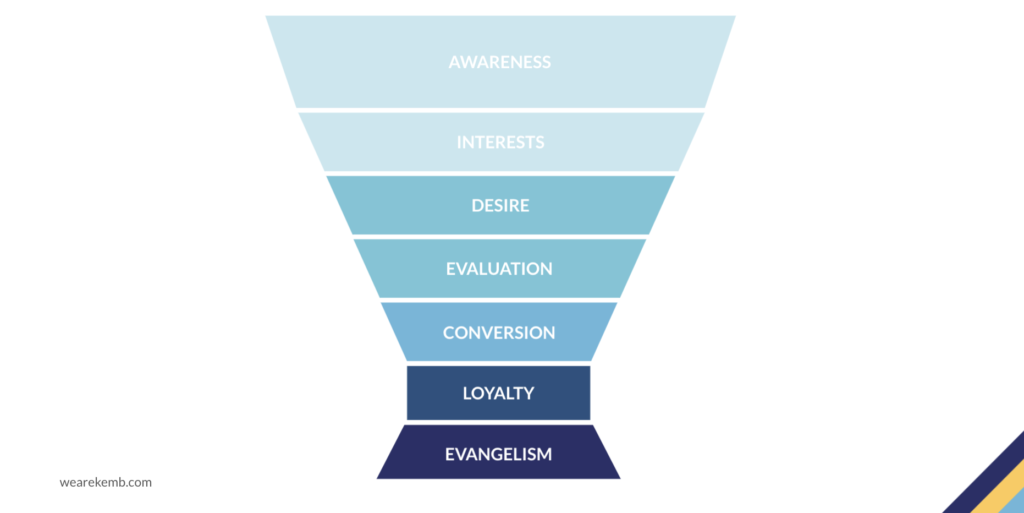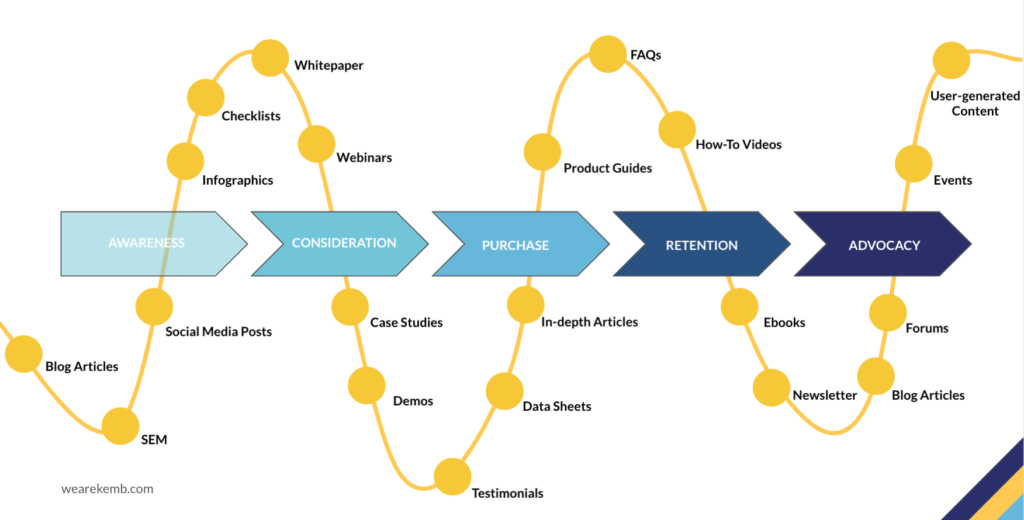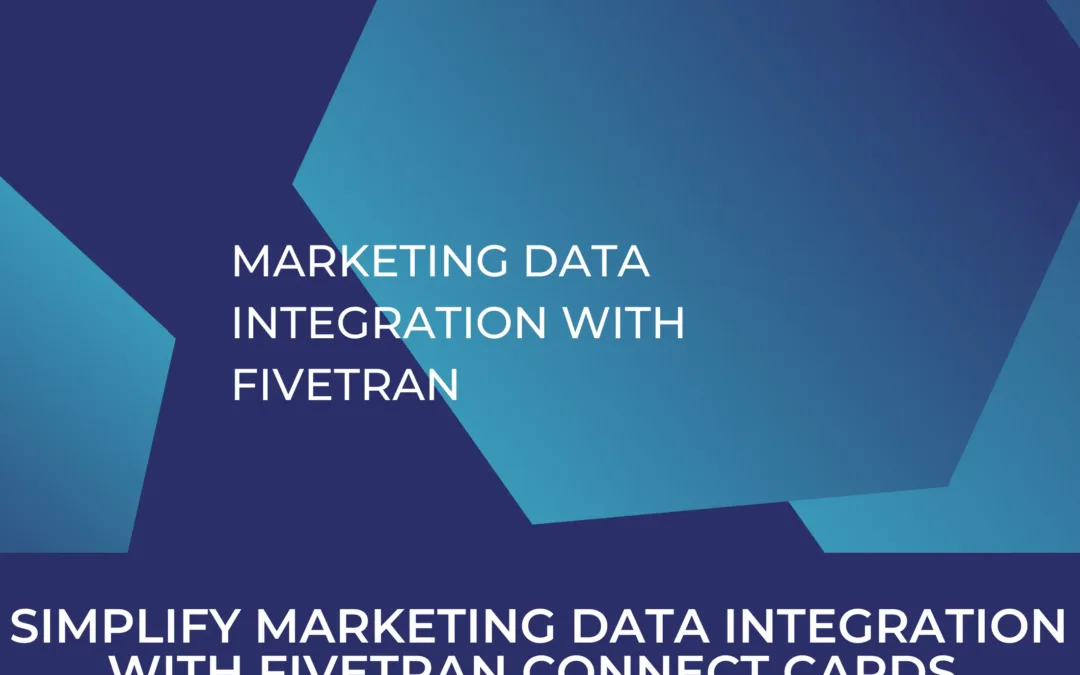Content Marketing Strategy: 8 Vital Steps
Content Marketing has long since become an established part of corporate marketing strategies. Value-added editorial content can play an integral part in an often rather complex and lengthy customer journey, specifically in B2B. Nevertheless, scepticism towards Content Marketing still exists due to a lack of clear understanding of its potential for a company. Additionally, organizations often struggle to take a strategic approach to using it in the most effective way and convey the multiple benefits of a content strategy in the context of both B2B and B2C.
Engaging content helps you on many levels. It helps increasing brand awareness. It supports the generation of leads. It is a cost-effective and sustainable advertising measure. But what is most important is that it offers real value to your potential clients. It serves them along their entire customer journey. It is inspiring and helps you gain trust and convince people of your product and your brand as a whole. In this article, we look at the most important steps to take for your strategy.
What is Content Marketing?
Content Marketing is basically the expression of a paradigm shift that can be observed in overall marketing communication. It manifests itself in a modern form of advertising that differs significantly from classic ways of promotion. Taking the customer’s perspective has become ever more significant in this context. It is a matter of focusing on and addressing customers’ problems and thereby generating attention for a product or rather for a solution to their problems instead of relying solely on proactive advertising.
At this point, Content Marketing strategy comes into play by putting the spotlight on the customer, his concerns, interests, preferences, and needs. The challenge: using informative content to arouse his curiosity, convey competence, and thus build lasting trust in a brand. And all this with value-adding content throughout an entire customer journey, rather than sales-driven headlines that focus on the product.
How does Content Marketing work?
At its core, Content Marketing relies on persuasion through content rather than motivation to buy. In other words, it is not about marketing a particular product, but rather about genuinely putting the individual customer in the spotlight, by addressing his or her specific problems and then formulating a feasible response. The key is to develop a trust-based relationship with customers by supporting them with meaningful and beneficial information at every stage of the customer journey and therefore along the entire marketing funnel.

It shows that those strategies are particularly successful which place special emphasis on customer needs and in which promotion only plays a subordinate role. A survey by the Content Marketing Institute, for example, indicates that in the B2B sector in particular, 88 percent of the most successful B2B content marketers place a high priority on customers’ need for comprehensive information. On the other hand, only one in two of the less successful companies does so.
The overarching goal is thus to engage and convince the target audience through value-added content, winning them over as clients and retaining their loyalty in the long term. With informative, advisory and entertaining material tailored as precisely as possible to suit the audience’s specific needs. The positive side effect: Content Marketing might outperform other forms of advertising in terms of costs, lead generation and, ultimately, churn rates.
The Relevance of good quality content (marketing)
The relevance of good quality content has always been a given. Ultimately, today’s Content Marketing does not differ greatly from traditional PR practice. With the possibilities of digitalization, however, further levels are opening up with regard to publication possibilities and thus towards the purpose of obtaining digital outreach.
At the same time, a declining relevance of classic advertising formats and advertising media can be observed. Customers are becoming increasingly indifferent to conventional advertising mechanisms and are now able to selectively consume exactly the content they are genuinely interested in. At the same time, people have learned to largely tune out advertising. Underpinning this trend is a change in media consumption behavior.
The phenomenon of second screening, for instance, refers to the fact that people are increasingly watching two monitors at the same time. As the supposed ‘main program’ is running on the big TV screen, the viewer is simultaneously surfing the Internet on his or her cell phone, with a correspondingly reduced level of attention for both ‘worlds’.
Content Marketing is an excellent response to fill this ‘gap’: With user-oriented types of content that correspond precisely to the wants and wishes of that particular clientele. And it is not just an advertising message being sent out, but instead something that the user discovers on his or her own and based on its relevance. Be it via the company’s own blog, on social media, external news portals or any third-party publishers: There are huge opportunities available for content publication. And while this strategy is already firmly integrated in the B2C area, it offers at least as much potential in the business to business area.
What are the main objectives of Content Marketing?
1. Brand Awareness
Content Marketing can contribute significantly to creating awareness towards a company and its image as a brand. Awareness is particularly important in that people tend to have more trust in brands they know, which in turn increases peoples’ willingness to buy their products. In this respect, engaging articles and blog posts in the B2B sector are very effective in generating initial attention for a brand. Similarly, the use of social media channels can play a role in positioning a brand in the market which is not to be underestimated.
A potential client who comes across an intriguing news article while researching a specific topic is unlikely to immediately buy your product, but will recall a worthwhile read. If he again stumbles upon a useful piece of information or eventually downloads a white paper that helps him solve a specific problem, he will have already had another positive experience with the brand, which in turn boosts trust in the brand and increases trust in your competency.
2. Lead Generation
A well-designed content strategy follows a holistic approach taking into account the entire customer journey in order to provide audiences with a comprehensive brand experience, thus creating and further qualifying leads. In the B2B sector particularly, lead nurturing needs to be carried out with even greater care compared to the B2C market, where purchasing decisions are more likely to be taken on impulse.
While certain topics may be particularly suitable to attract initial attention and to generate early marketing leads, it is important to keep those engaged in the follow-up for instance, by providing knowledge demonstrated in more specific pieces of content, such as webinars or a sophisticated guide. And eventually, further down the funnel, at the stage of a purchase decision, in the form of case studies, which can be a final lever towards turning a lead into a customer.
What’s important is that content must be tailored to the various stages of the customer journey to facilitate the smoothest possible experience. And naturally, this journey isn’t over with the very first purchase, but can be extended very effectively using Content Marketing to ensure long-term customer loyalty.
3. Competitive Positioning
Whether it’s value-added content in the form of topical articles, studies or exciting case studies, a wide and varied range of different types of content can be used to express one’s own expertise. The more successfully a company manages to position itself as a trusted authority, the more it can differentiate itself from its competitors and thus gain a competitive advantage.
In the context of B2B, businesses are even more challenged to demonstrate quality in order to stand out from competition. Content Marketing provides an opportunity to demonstrate you understand your clientele’s needs and are capable of assisting them. Fuel the trust in your expertise, let prospects know how you work, how you implement solutions, and position the company as a well-versed partner in the highly competitive marketplace. Use expertise to convince. Needless to say, this is easier said than done. It takes high-quality and unique editorial content. Well-written stories are sharable, extend reach in the relevant market, strengthen reputation and increase exposure in search results.
4. Organic Visibility
A well-executed strategy leads to higher visibility in the search results. Not only does this directly result in increasing organic and thus non-paid traffic (a note in this context: If you have ever observed unusual traffic spikes, you might be interested in our article on bot traffic), but it obviously has a positive effect on one’s own reputation in the surrounding field as well. If every relevant issue is covered by a brand’s response in search engine results, then the brand will increasingly be perceived as a reliable source not only for users, but for search engines as well.
Search engines reward high-quality content: The more compelling your contributions are, the better your chances for a good ranking in search results and thus potentially more clicks on your website content. Additionally, having a well thought-out strategy allows for real authority to be established in subject fields. It goes without saying this takes time and effort. But once authority has been established, it not just strengthens brand perception, but has a lasting effect on the presence in google’s results lists. Further content on a related field usually reaches higher positions more easily, as Google recognizes the source as an authority (e.g. your blog).
5. A better understanding of your Target Customers’ Needs
What topics are really relevant to your audience? Which topics are less interesting to people? Where do people drop off, and which pieces do they particularly enjoy consuming? By regularly reviewing your content performance, you’ll gain valuable insights to develop an ever better understanding of your audience’s needs and to tweak both content and products accordingly. Before you even start generating possible content ideas, you should try to get as precise a picture as possible of your specific customers, their goals, wishes and needs. Personas are particularly helpful for this purpose: they provide important guidance and orientation for tailoring your marketing planning as precisely as possible to the clients you want to address. You can use our B2B Buyer Persona Template for this purpose.
Excursion: Customer Journey in B2B
The buying process in B2B, is often more complex and longer than it is in B2C. Within the B2B sector, problems to be solved and their complexity are usually bigger and more costly. Company decisions often take several months to be made before the actual buying process takes place. Moreover, the decision is usually made in consultation rather than individually.
Depending on the sector and level of complexity, customers go through correspondingly lengthy cycles from initial awareness to eventual purchase, and different topics are more or less suitable for each step. Initial awareness is usually not based on any specific search. Potential clients presumably haven’t heard of you yet, let alone have any idea of what you offer. Whether it’s via noteworthy blog posts, relevant comments on industry related sources, or engaging social media postings: you can generate initial awareness without customers already actively searching for you.

Content in the different stages of a customer journey
Depending on the sector and level of complexity, customers pass through relatively long stages from initial awareness to the eventual purchase, with different subjects being more or less suitable for each of these stages. Initial awareness is not usually the result of concrete research.
In the awareness stage itself, you can generate exposure for your brand once customers have already identified a problem and are starting to research potential solutions. At this point, you need to provide more specific content, offering the opportunity to position yourself as an expert source of advice via value-adding information and compelling ideas for solutions. Users will intensively look into a specific issue and conduct correspondingly more in-depth research.
Only then do they enter a consideration stage, weighing up alternatives against each other. At this stage, content again plays an important role when it comes to credibly underlining why your company’s product is the right solution for the specific problem. Using rich content around a product to make it more comprehensible and tangible, providing transparency and a very clear idea of exactly how the solution works.
Finally, the purchase decision follows. Be it through interviews with satisfied customers or case studies that vividly describe specific approaches to problems, contextual content can serve as a final convincing factor.
Lastly, the established customer relationship needs to be maintained and more ideally evolved. For instance, tutorial videos can be used to accompany implementation processes, while handbooks and onboarding guides ease the way for getting up and running. However your product appears, a range of suitable types of editorial content can be used to help develop the established customer relationship and, not least, to enable the company to position itself as a suitable partner for subsequent projects and further challenges.
There are good reasons to invest in content
Content Marketing holds tremendous potential for a successful customer journey. The added value of a frictionless experience from initial awareness to a lasting customer relationship using value-adding content cannot be overestimated. Before we For Content Marketing to unfold its qualities, it takes not only time, but in particular a carefully crafted preparation and implementation of a strategy that is continuously monitored and readjusted.
But what about the best strategic approach to content marketing? What steps should I take? Well, we’ll tell you directly.
RECAP: the 5 most important goals of Content Marketing
Before we dive into the strategic part, let’s quickly sum up the most important goals of content marketing. And in our opinion, it doesn’t matter whether you are working in the B2B sector or in the B2C sector. The main targets are similar, with a subtle tactical difference. While the focus in the B2C area is often more on creating entertaining content, in a B2B environment, the educational component is particularly important. When it comes to strategic positioning, the choice of measures and tactics can differ as well. Content marketing strategies can look very different in different sectors. Always factor in the specifics of the industry, your product, and the environment. Besides, there are several general goals we can identify as fundamental.
- The long-term increase of brand awareness
- Lead generation and nurturing
- A strengthening of your position vis-à-vis the competitive landscape
- Increasing organic visibility and website traffic
- Gaining a deeper understanding of your target customers
Developing your B2B Content Marketing Strategy
Now that we have an idea of the potential of content marketing, it’s time to get going. Note that content activities can fizzle out and fail to achieve the desired success. So what it needs is a solid strategic foundation to prevent that. But before you even embark on the actual process of production, you need to answer some key questions. Establish a precise idea of what qualities make your company stand out from the crowd. What distinguishes your company from others? How do you want people to perceive you? Where are your strengths and weaknesses versus competitors? You need answers to questions like these within the framework of strategic alignment.

Step 1: CreatE Buyer Personas – Know who you are talking to
Who are you producing content for? Try to get as accurate a picture as possible of your target group. What are their specific needs? And in what stages of the customer journey? Which topics are most relevant, and why and in which phase. Then think what potential content in each of those phases could you offer to them. Also consider the form of communication and the channels through which they communicate. Finally, keep in mind production matters. In the end, the preferences of your target audience should set the pace. All this will have significant impact on the kind of content you need to create, at what frequency, and by whom.
Try putting yourself in your customers’ shoes and create buyer personas. What might their journey look like and where can you tie in with value-adding pieces of content? Depending on the product, you content may be interesting for various personas. Address key pain points and provide answers to specific business challenges. Buyer personas will help you to develop a more accurate idea of the targeted customers. With a clear image of their issues, you will provide better quality content. Content designed to serve with good advice in the right place. To start generating ideas right away, you can download our B2B Buyer Persona Template.
Step 2: Choose your Marketing Channels – Where are you talking to them?
How people consume your content also plays an important role. The best how-to videos on YouTube can be off target, if your audience does not use YouTube as a source for help. So you need to figure out where your readership resides. Maybe there is no need for daily Linkedin posts when you can instead help your audience with a single article in your blog. Or you might reach many more by publishing a whitepaper on a relevant industry platform or even a microsite. Always keep in mind that with so many options, it’s even more important to find the ones that are right for you. Time and resources will always have limits, so you should set strategic priorities.
Many organizations use some form of social media as part of their content strategy. Yet not all of them follow a thorough plan in the process. Consider that channels differ: both in terms of their audiences and appropriate targets. While one may hold promise for to increase brand awareness, others may be better suited for lead generation.
Although there may be great value in social media for your strategy, for instance LinkedIn is considered the most important channel in the B2B sector, a strategy should not blindly follow general tendencies, but rather be geared to the specific case. Perhaps, in a given scenario, case studies or whitepapers on the company website or with external publishers are much better suited for your purposes.
Analyzing what your most important competitors do in the area also offers invaluable input. Not only as an indicator for promising channels, but also to point towards loopholes and niches that are still unoccupied.
Step 3: Find your Tone of Voice – How are you talking?
Pay special attention to the tone of voice you choose. This can especially be critical in the B2B sphere. Pay attention to the use of language in your field. How do successful competitors in your industry communicate? They can serve as benchmarks and provide orientation on what style works in your field.
At the same time, you should always aim to establish a personal style. Yes, it should still be in line with the industry norms, but it also needs to emphasize your own brand qualities. At the same time, you should always aim to establish a personal style. Yes, it should still be in line with the industry norms, but it also needs to emphasize your own brand qualities. Companies who convey their personality remain in the minds of their target group. And they are less likely to be replaced.
Step 4: Competitor Analysis & SEO Audit – Know where you stand
A proper seo audit offers a suitable start to assess the status quo of your content. First, review how well you perform on core topics along the entire customer journey. You should always keep the entire funnel in mind and ensure a balanced distribution of content. Especially in the B2B sector, it is crucial not only to provide content for initial attention. Rather, it is about supporting potential customers as they continue their journey. When they are already looking for concrete solutions, you should offer the most competent advice. When they are comparing offers, your case studies must provide the final conviction. When they have difficulties using your product, your How-To articles should provide solutions.
A SEO analysis of competitors reveals the topics they rank for, their positioning, keywords of importance within the field, etc. Try to incorporate all of these elements in the content development process.
Operationalization
Once you established the strategic basis, you need to translate it into an ongoing and monitorable process. While few B2B marketers question the fundamental value of content marketing (4 out of 5 B2B companies rely on content as part of their marketing strategy), many still fail to efficiently execute and evaluate it.
This makes content marketing opaque and its actual impact difficult to assess.In fact, many marketers complain that they cannot measure the effectiveness of their content marketing efforts. One in three companies using content marketing has no documented strategy. One in four would describe their own strategy as not on target, according to this Statista Study.
These findings not only underline a challenge that content marketing is apparently facing. It also shows the need for strategic competencies within a company as well.
As long as many businesses do not yet have a mature strategic basis, there is potential to outperform competitors. They may still be in their early stages of implementing sophisticated processes.
Step 5: Define KPIS – Know your data to define your goals
It is essential to learn how to use and interpret your data and to transform it into actionable insights, otherwise content marketing is an overly costly and time-consuming process. Define clear KPIs to measure performance to measure the ROI of your content activities and set those in relation to your other marketing spends. First, It will help build internal acceptance of content marketing and justify a budget. Above all, it is the basis for sustainable development and optimization.
Well thought-out planning and tracking of your activities is indispensable. Ensure you have a proper set of tools to track activities and performance. Set clear objectives and metrics to test activities, and be sure of appropriate reporting. Goals should be SMART, i.e. specific, measurable, achievable, relevant and timely.
Appropriate KPIs are varied and tailored to individual goals. For example, if your primary goal is to develop brand awareness, different marketing KPIs are appropriate than if you want to improve the ratio of MQL to SQL leads.
Step 6: Focus – What matters the most?
Identify your core topics and develop a structured editorial execution roadmap. At the very start focus on the most relevant topics rather than tackling hundreds of subjects simultaneously. This will help you build authority in individual fields step by step.
Establish clear responsibilities, whether internally or through external support. Just be sure to have a clear process in place for day-to-day operations. Many companies, especially small and medium-sized ones, rely on an in-house expert or small teams. Others still prefer not to invest in a full-time in-house content position. In this case, you need to find an external partner to manage all aspects of the production process. Unless a structured workflow is in place from the beginning, it will get difficult to achieve sustainable growth.
Also, set up a roadmap to maintain editorial integrity of published content. Doing so will help to ensure brand alignment.
Step 7: Readjust – Be ready to change parts of your strategy
To evaluate the success of your strategy, you need to have a detailed understanding of what is working well. What content is driving traffic? Which content is converting traffic? What is the ratio of production efforts, costs, and benefits? The more you create, the more data you generate to readjust and fine-tune your content marketing strategy.
Step 8: Scale your Content Marketing Strategy
You know your competitors inside out. You have an in-depth understanding of your core audience and their needs. You have invested significant time and effort in creating a sophisticated strategy. Your editorial team is delivering content you believe in. You basically did everything, but the desired effect has not yet materialized? For the most efficient use of content, you need scaling to boost reach.
In addition to the ongoing provision of high-quality content, key factors include search engine-optimized formatting. For this reason, you need to review the setup for search engines to make sure that your quality content can be found to drive awareness and traffic. So, make sure to optimize your website for search engines constantly.
Another way for scaling up your content marketing efforts is to leverage paid advertising. In particular, if you have not yet established authority for a topic. Most likely this is due to the fact that you have not yet created a sufficient amount of content or have not yet optimized it for search engines. If that is the case, consider a further push via paid distribution. If you invested time and effort in the creation of promising pieces of content, use targeted support via paid marketing campaigns. Consider which channels to use for distribution, whether you want to highlight your article in Google search, or perhaps draw attention to a case study on Linkedin to encourage potential leads to download it.
Whether it’s search engine marketing, social media advertising, or even native articles on other platforms to generate awareness: there’s no one golden rule, so try and see what works best in your industry and for your unique content.
Conclusion
As we note that Content Marketing is in fact much more than writing interesting stories on a topic you are comfortable with ( not that this was an easy thing to do), it takes a lot more: a great deal of thought, a lot of preparatory work, and last but not least, a lot of ongoing review and fine-tuning. Or else the results will fail to come, and this likely comes with a big investment of time and money. Yet, smart strategic content planning can contribute significantly to enhancing the customer journey, especially in the often rather complex B2B business. Moreover, it can have a lasting impact on the development of loyal customers. In case you need any help on your content roadmap, please don’t hesitate to contact us! We are happy to help you with all strategic and operational issues.




